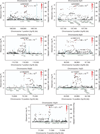Meta-analysis identifies six new susceptibility loci for atrial fibrillation
- PMID: 22544366
- PMCID: PMC3366038
- DOI: 10.1038/ng.2261
Meta-analysis identifies six new susceptibility loci for atrial fibrillation
Abstract
Atrial fibrillation is a highly prevalent arrhythmia and a major risk factor for stroke, heart failure and death. We conducted a genome-wide association study (GWAS) in individuals of European ancestry, including 6,707 with and 52,426 without atrial fibrillation. Six new atrial fibrillation susceptibility loci were identified and replicated in an additional sample of individuals of European ancestry, including 5,381 subjects with and 10,030 subjects without atrial fibrillation (P < 5 × 10(-8)). Four of the loci identified in Europeans were further replicated in silico in a GWAS of Japanese individuals, including 843 individuals with and 3,350 individuals without atrial fibrillation. The identified loci implicate candidate genes that encode transcription factors related to cardiopulmonary development, cardiac-expressed ion channels and cell signaling molecules.
Figures


References
-
- Fuster V, et al. ACC/AHA/ESC 2006 Guidelines for the Management of Patients with Atrial Fibrillation: a report of the American College of Cardiology/American Heart Association Task Force on Practice Guidelines and the European Society of Cardiology Committee for Practice Guidelines (Writing Committee to Revise the 2001 Guidelines for the Management of Patients With Atrial Fibrillation): developed in collaboration with the European Heart Rhythm Association and the Heart Rhythm Society. Circulation. 2006;114:e257–e354. - PubMed
-
- Gudbjartsson DF, et al. Variants conferring risk of atrial fibrillation on chromosome 4q25. Nature. 2007;448:353–357. - PubMed
Publication types
MeSH terms
Grants and funding
LinkOut - more resources
Full Text Sources
Medical
Molecular Biology Databases

